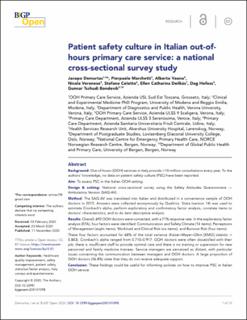| dc.contributor.author | Demurtas, Jacopo | |
| dc.contributor.author | Marchetti, P | |
| dc.contributor.author | Vaona, Alberto | |
| dc.contributor.author | Veronese, Nicola | |
| dc.contributor.author | Celotto, Stefano | |
| dc.contributor.author | Deilkås, Ellen C Tveter | |
| dc.contributor.author | Hofoss, D | |
| dc.contributor.author | Bondevik, Gunnar Tschudi | |
| dc.date.accessioned | 2021-04-06T18:56:31Z | |
| dc.date.available | 2021-04-06T18:56:31Z | |
| dc.date.created | 2021-01-09T17:27:33Z | |
| dc.date.issued | 2020 | |
| dc.identifier.issn | 0960-1643 | |
| dc.identifier.uri | https://hdl.handle.net/11250/2736453 | |
| dc.description.abstract | Background Out-of-hours (OOH) services in Italy provide >10 million consultations every year. To the authors' knowledge, no data on patient safety culture (PSC) have been reported.
Aim To assess PSC in the Italian OOH setting.
Design & setting National cross-sectional survey using the Safety Attitudes Questionnaire — Ambulatory Version (SAQ-AV).
Method The SAQ-AV was translated into Italian and distributed in a convenience sample of OOH doctors in 2015. Answers were collected anonymously by Qualtrics. Stata (version 14) was used to estimate Cronbach’s alpha, perform exploratory and confirmatory factor analysis, correlate items to doctors’ characteristics, and to do item descriptive analysis.
Results Overall, 692 OOH doctors were contacted, with a 71% response rate. In the exploratory factor analysis (EFA), four factors were identified: Communication and Safety Climate (14 items); Perceptions of Management (eight items); Workload and Clinical Risk (six items); and Burnout Risk (four items).
These four factors accounted for 68% of the total variance (Kaiser–Meyer–Olkin [KMO] statistic = 0.843). Cronbach’s alpha ranged from 0.710–0.917. OOH doctors were often dissatisfied with their job; there is insufficient staff to provide optimal care and there is no training or supervision for new personnel and family medicine trainees. Service managers are perceived as distant, with particular issues concerning the communication between managers and OOH doctors. A large proportion of OOH doctors (56.8%) state that they do not receive adequate support.
Conclusion These findings could be useful for informing policies on how to improve PSC in Italian OOH service. | en_US |
| dc.language.iso | eng | en_US |
| dc.publisher | Royal College of General Practitioners | en_US |
| dc.rights | Navngivelse 4.0 Internasjonal | * |
| dc.rights.uri | http://creativecommons.org/licenses/by/4.0/deed.no | * |
| dc.title | Patient safety culture in Italian out-of-hours primary care service: a national cross-sectional survey study. | en_US |
| dc.type | Journal article | en_US |
| dc.type | Peer reviewed | en_US |
| dc.description.version | publishedVersion | en_US |
| dc.rights.holder | Copyright 2020 The Authors. | en_US |
| cristin.ispublished | true | |
| cristin.fulltext | original | |
| cristin.qualitycode | 2 | |
| dc.identifier.doi | 10.3399/bjgpopen20X101098 | |
| dc.identifier.cristin | 1868232 | |
| dc.source.journal | British Journal of General Practice | en_US |
| dc.identifier.citation | British Journal of General Practice. 2020, 4 (5) | en_US |
| dc.source.volume | 4 | en_US |
| dc.source.issue | 5 | en_US |

